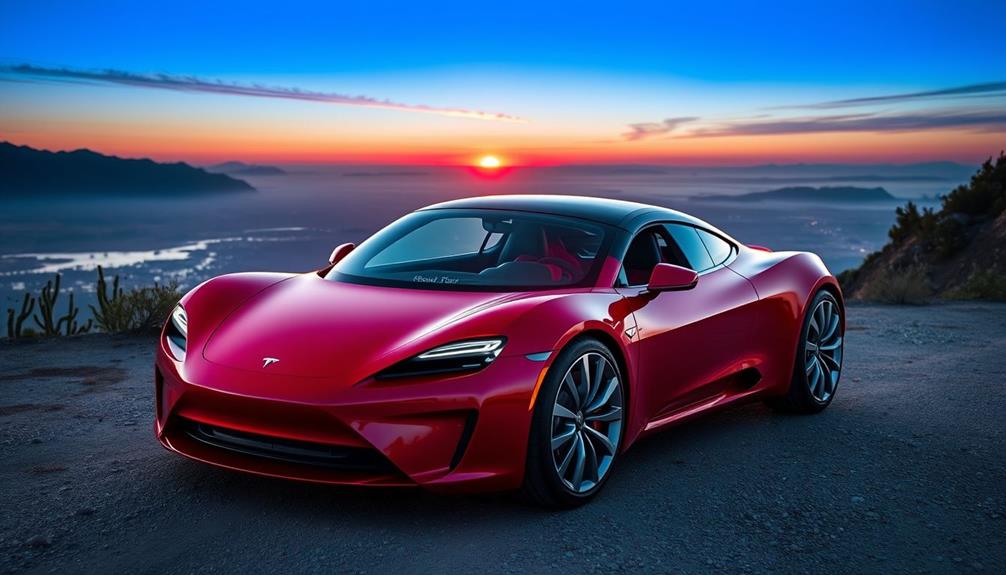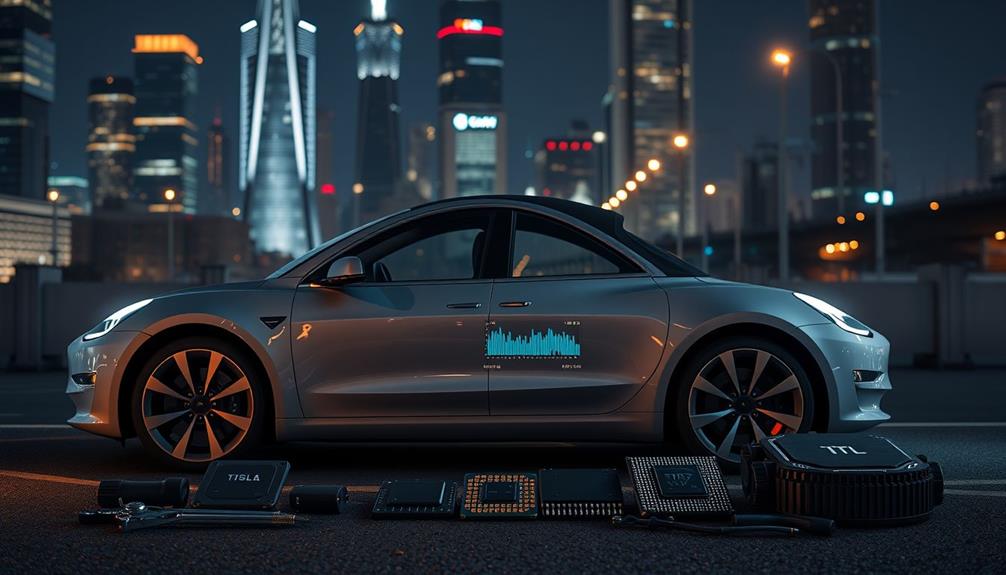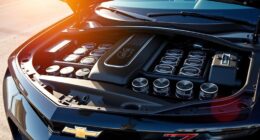The Tesla Roadster's price tag starts at about $200,000 for the base model, making it a standout in the luxury electric sports car market. If you're eyeing the limited-edition Founders Series, be prepared for a price around $250,000. The exclusivity comes from its limited production, which enhances its appeal among collectors. Performance-wise, it boasts a 0-60 mph acceleration in just 1.9 seconds, making it one of the fastest production cars. Curious about what other features and specs this ultimate Tesla offers? There's more to uncover that'll surely pique your interest.
Key Takeaways
- The base model of the Tesla Roadster is projected to start at approximately $200,000.
- A limited-edition Founders Series will be priced around $250,000, with only 1,000 units available.
- Initial reservation fees of $50,000 were halted in 2021 due to production delays.
- Rocket-equipped versions with the SpaceX Package are expected to carry a premium price.
- The Roadster's high price reflects its performance capabilities, justifying its niche appeal in the luxury electric sports car market.
Roadster Production Timeline

Tracking the Roadster production timeline reveals a journey marked by ambition and delays. The second-generation Roadster was first disclosed in November 2017, with a production debut initially expected in 2020. However, Tesla's focus shifted to the Model 3 and Model Y, pushing the Roadster's timeline back considerably.
You can now anticipate its production debut in 2025, launching as a 2026 model.
As excitement builds, the new Tesla Roadster is expected to be a halo vehicle for the brand, showcasing cutting-edge technology and performance rather than targeting mass-market appeal. This means limited production is likely, which can affect its availability and exclusivity.
With a high price point anticipated, the Roadster won't be a high-volume seller. Instead, it'll cater to a niche market of enthusiasts willing to invest in Tesla's vision of electric performance.
Recent updates suggest a renewed focus on the Roadster's development, with an official announcement expected in late 2024.
As the launch date approaches, you can look forward to more details and performance demonstrations that will surely generate buzz around this remarkable vehicle.
Performance Specifications

The 2026 Tesla Roadster is set to redefine performance benchmarks in the electric vehicle market.
You'll be thrilled to know it boasts an astonishing 0-60 mph acceleration time of just 1.9 seconds, and with the optional SpaceX Package, that could drop to under 1 second. This electric sports car doesn't just excel in acceleration; it also features a top speed exceeding 250 mph, making it one of the fastest production cars in the world.
Under the hood, the Roadster employs a cutting-edge three-motor setup, delivering over 1,000 horsepower and approximately 758 lb-ft of torque.
This powerful configuration guarantees that you get unmatched performance on demand. Plus, with all-wheel drive as standard, you'll enjoy enhanced traction and stability, whether you're on a track or traversing twisty roads.
Anticipate a quarter-mile time of around 8.8 seconds under ideal conditions, setting a new benchmark for electric sports cars.
The 2026 Tesla Roadster isn't just a vehicle; it's a statement of performance, speed, and technological innovation that you won't want to miss.
Historical Context of Delays

You might've noticed that the second-generation Tesla Roadster, initially set for delivery in 2020, has faced numerous setbacks, pushing production to 2025.
Tesla's shift in focus to the more popular Model 3 and Model Y has also played a significant role in these delays.
With the added challenges of the global pandemic and supply chain issues, the Roadster's timeline has been anything but smooth.
Production Timeline Challenges
Delays in the production timeline of the second-generation Tesla Roadster have raised eyebrows among enthusiasts and potential buyers alike. Initially promised for delivery in 2020, the Roadster's launch has been postponed repeatedly.
Tesla's shift in focus toward the more mass-market Tesla Model 3 and Model Y greatly impacted the Roadster's development. Compounding these delays are global events, particularly the pandemic, which further complicated the automotive production landscape.
Originally showcased in November 2017, the engineering and design completion of the Roadster is now expected in 2023. Production is set to begin in 2024, but with Elon Musk projecting deliveries to start in 2025, it's clear that the wait will be extensive.
Skepticism regarding the viability of high-priced electric sports cars has also created hurdles for Tesla. Potential buyers are left wondering if the Roadster will meet their expectations or even make it to market as planned.
With these production timeline challenges, it's essential for Tesla to address these issues to reassure enthusiasts and maintain the Roadster's allure in the competitive electric vehicle market.
Market Focus Shifts
Amidst the shifting landscape of the automotive market, Tesla's focus has increasingly leaned toward producing high-volume models like the Model 3 and Model Y, sidelining the second-generation Roadster. Initially promised for delivery in 2020, the Roadster has faced significant delays, with production now anticipated to begin in 2025. This shift underscores Tesla's strategy to prioritize mass-market vehicles over high-priced models, reflecting changing consumer demands.
| Event | Impact |
|---|---|
| Initial Roadster Launch | Promised for 2020 |
| Focus Shift | Production of Model 3 and Model Y |
| New Production Start | Expected in 2025 |
| Global Events | Pandemic setbacks |
| Industry Skepticism | Concerns over high-priced models |
As you can see, the delays have not only frustrated enthusiasts but also raised questions about the Roadster's market performance. With growing skepticism regarding the viability of high-priced electric sports cars, the ultimate success of the Roadster upon its eventual release remains uncertain. Tesla's current strategy might just reshape the future of luxury electric vehicles.
Pricing Breakdown

The pricing breakdown for the 2026 Tesla Roadster reveals a clear picture of its luxury positioning in the electric sports car market. The base model is projected to start at around $200,000, firmly placing it among high-end electric vehicles.
If you're considering a more exclusive option, the limited-edition Founders Series comes with a price tag of approximately $250,000, with only 1,000 units available. This exclusivity makes it a sought-after choice for collectors and enthusiasts.
Reservations for the Roadster initially required a fee of $50,000, although this process was halted in 2021 due to ongoing delays. If you're keen to get your hands on one, the limited production run adds to its allure.
While the base model is already a significant investment, the rocket-equipped versions with the SpaceX Package are expected to carry a premium price, but exact figures haven't been confirmed yet.
Competitor Comparisons

When comparing the 2026 Tesla Roadster to its competitors, you'll notice a significant price gap that highlights its luxury status in the electric sports car market. The base price of the Roadster is projected to start around $200,000, while the limited-edition Founders Series models are expected to reach approximately $250,000.
In contrast, the 2024 Maserati GranTurismo Folgore comes in at a starting price of $193,995, positioning it slightly lower than the Roadster's base model.
The 2025 Maserati GranCabrio Folgore is priced at $206,995, making it competitive but still below the Founders Series Roadster.
While Maserati focuses more on luxury and style, the Tesla Roadster emphasizes performance, boasting an impressive 0-60 mph time of just 1.9 seconds. This exceptional performance may justify the Roadster's higher price compared to the Maserati models, which are more aligned with traditional luxury sports cars.
Ultimately, if you're looking for cutting-edge technology and unmatched acceleration, the Roadster stands out in the electric sports car segment, making its elevated price point seem reasonable.
Autopilot and Safety Features

How does the Tesla Roadster enhance your driving experience with its Autopilot and safety features? The 2026 Roadster is set to include advanced driver-assistance systems as standard, markedly improving your safety on the road.
With features like automated emergency braking and lane-departure warning, you'll benefit from a driving experience that prioritizes protection and peace of mind.
Tesla's Autopilot technology aims to make your journeys easier, but it's vital to stay informed about its performance. While the Roadster promises these safety features, it's worth noting that recent data shows an increase in crashes following software updates. As a result, staying vigilant while using Autopilot is imperative.
Currently, no crash test ratings are available for the Roadster since it's still in the concept phase. However, you can expect the safety warranty to align with Tesla's existing lineup, offering a standard 4 years/50,000 miles warranty and an 8-year powertrain warranty.
This gives you added assurance as you consider investing in this high-performance vehicle. Overall, the combination of advanced safety features and the warranty makes the Roadster a compelling option for those seeking both speed and security.
Market Sentiment

As you consider the Tesla Roadster's steep price tag, it's important to weigh how it stacks up against competitors in the luxury electric sports car market.
Rising skepticism about Tesla's service and safety could influence your perception of whether the cost is justified.
With many alternatives popping up, you might find yourself questioning if the Roadster still holds its value in a rapidly changing landscape.
Consumer Perceptions of Pricing
Consumer perceptions of the Tesla Roadster's pricing reveal a complex landscape shaped by both admiration and skepticism. With a base price projected at $200,000 and the limited-edition Founders Series around $250,000, consumers see this as a high-performance luxury vehicle.
However, these figures can deter potential buyers, especially when many are drawn to more affordable electric vehicles flooding the market.
Surveys indicate that while some consumers admire the Roadster's impressive specifications, the steep price tag raises concerns about value. You might find yourself questioning whether the investment outweighs the benefits, particularly when competitors offer compelling alternatives.
Additionally, the limited production volume suggests exclusivity, which can attract collectors but also fosters skepticism about the Roadster's viability as a mass-market electric sports car.
As a consumer, it's crucial to weigh these perceptions against your personal expectations and financial commitment. While the allure of owning a Tesla Roadster is undeniable, the current market conditions and shifting sentiments may prompt you to reconsider whether this high-performance model aligns with your automotive aspirations.
Competitor Pricing Comparisons
When comparing the Tesla Roadster's pricing to its competitors, it's clear that the luxury electric sports car market is becoming increasingly competitive. The base price for the 2026 Roadster is projected to start at $200,000, while the limited Founders Series will come in at around $250,000.
In contrast, the 2024 Maserati GranTurismo Folgore starts at $193,995, making it a compelling choice for those seeking electric performance without reaching the Roadster's price point. Additionally, the upcoming 2025 Maserati GranCabrio Folgore is set to debut at $206,995, further emphasizing the premium nature of electric luxury vehicles.
While the Roadster's higher price reflects its impressive performance specs—like a 0-60 mph time of just 1.9 seconds and a 620-mile range—this niche appeal may not resonate with more mainstream consumers.
Market sentiment remains cautious regarding these high-priced electric sports cars, as potential buyers weigh their options against more affordable models like the Tesla Model 3, which starts at $40,630.
Ultimately, the pricing landscape will considerably influence buyer choices in this evolving segment.
Future Outlook

There's a lot of excitement surrounding the future of the Tesla Roadster, especially with its anticipated reveal in late 2024 and production set to begin in 2025.
As a 2026 model, the Tesla Roadster aims to redefine performance with jaw-dropping specifications, including a 0-60 mph acceleration time of just 1.9 seconds and an impressive range of 620 miles.
This powerhouse won't come cheap, though. The base price is expected to be around $200,000, while the limited-edition Founders Series will likely run you about $250,000.
Given the high production costs and unique components, you can expect the Roadster to be produced in limited volumes. This exclusivity positions it more as a halo vehicle rather than a mass-market option.
With initial deliveries slated for 2025, the anticipation builds as the automotive world waits to see how the Roadster's performance stacks up against competitors.
As the launch date approaches, consumer interest is likely to soar, especially among those who appreciate cutting-edge technology and luxury in one sleek package.
Keep an eye out; the Tesla Roadster's future looks bright and promising!
Frequently Asked Questions
How Much Will the Spacex Tesla Roadster Cost?
You can expect the SpaceX Tesla Roadster to considerably increase in price, though exact figures aren't confirmed yet. Given its exclusivity and high demand, budgeting over $250,000 seems reasonable for this exceptional vehicle.
How Much Is the Highest Price Tesla Roadster?
Only 1,000 units of the Founders Series Tesla Roadster will be produced, making it incredibly exclusive. You're looking at a price of around $250,000 for this limited-edition model, which emphasizes its rarity and desirability.
How Much Is the Tesla Roadster 2025?
You can expect the 2025 Tesla Roadster to start around $200,000, with the limited-edition Founders Series priced at approximately $250,000. Keep an eye out for additional costs related to optional features as well.
What Is the Most Expensive Version of Tesla?
Imagine cruising in a sleek, futuristic vehicle; the most expensive Tesla is the Founders Series Roadster, priced around $250,000. With only 1,000 available, it’s a rare gem that blends luxury and performance seamlessly. The performance of the Founders Series Roadster is unparalleled, with a top speed of over 250 mph and acceleration from 0 to 60 mph in just 1. 9 seconds. The sleek design and cutting-edge technology make it a coveted choice for wealthy car enthusiasts. However, with brand new Tesla pricing on the rise, the Founders Series Roadster is not only a status symbol but also a valuable investment for the future.
Conclusion
In the end, you might wonder if the Tesla Roadster is worth the hefty price tag. While it's true that the initial costs are steep, consider the groundbreaking performance, advanced technology, and the potential for long-term savings on fuel and maintenance. Tesla's commitment to innovation means you're not just buying a car; you're investing in the future of driving. With its unmatched specs and features, the Roadster may just redefine what you expect from a high-performance vehicle.










